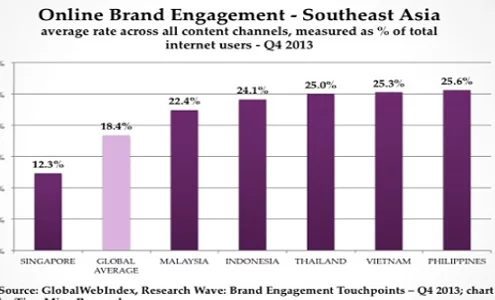Voice Search Optimization: Preparing for the Future of Search in the Philippines

“Hey Siri, what’s the best nail salon near me?”
“Alexa, find me the closest convenience store.”
If you’ve heard someone speak these phrases into their smartphone or have probably done so yourself, you’re already experiencing voice search SEO. And here’s the kicker: your customers are most likely utilizing it too. With voice-activated devices becoming increasingly prevalent, Filipino businesses need to hop on the bandwagon of voice search optimization in the Philippines or risk getting left behind.
But what exactly is voice search, and why should your business care?
What is voice Search?
Voice-enabled search, more commonly known as voice search, is the technology that lets users perform online searches simply by speaking their queries aloud, rather than typing them. From smartphones and virtual assistants like Siri, Google Assistant, and Amazon Alexa to smart home devices, voice search leverages artificial intelligence and natural language processing to understand and respond to spoken queries.
Voice search is no longer just an emerging trend; it’s swiftly becoming ingrained in everyday life. In fact, there are 1 billion voice searches each month via mobile and voice search devices. Smartphones, for example, are perfectly suited for quick, hands-free voice queries. Are you driving? Jogging? Carrying too many bags at once? Voice search allows you to multitask, search for information, and find local businesses effortlessly.
Why Voice Search Matters?
The rise of voice search isn’t coincidental—it’s driven by distinct trends. As a business, understanding these trends gives you a competitive advantage. It may seem like a futuristic concept, but voice search is already shaping how consumers discover products and services. It’s crucial for your business to stay ahead of the curve to stay relevant.
So, why is voice search SEO becoming more popular by the day?
1. Growing Adoption
Voice search adoption is rapidly expanding globally, and the Philippines is no exception. Smart speakers, virtual assistants like Siri and Google Assistant, and smart home devices are becoming mainstream as more Filipino households and professionals embrace digital convenience. It’s predicted that more than half of all internet searches will be conducted by voice, and nearly 58% of consumers are already using voice search to find local information. Businesses that recognize this upward trajectory can proactively adjust their digital strategies to capture a larger audience.
2. Mobile Dominance
The Philippines is a mobile-first nation, with an estimated 4.91 million smartphone users in 2024. Mobile devices naturally lend themselves to voice search due to their convenience and ease-of-use, especially when multitasking or on the go. Voice search aligns perfectly with this trend, offering users hands-free browsing and instantaneous answers. Filipino businesses must ensure their websites and content are mobile-friendly, quick-loading, and structured to deliver concise responses to mobile users, capitalizing effectively on this significant shift in online behavior.
3. Conversational Queries
Unlike traditional typed searches, voice queries are more conversational, longer, and phrased naturally, often mirroring spoken language. Users tend to speak queries as complete questions (“Where’s the nearest coffee shop?”) instead of using fragmented keywords (“coffee shop nearby”). This fundamental shift necessitates adopting conversational search strategies, requiring businesses to create content that directly answers typical spoken questions. Businesses must rethink their keywords and embrace conversational search habits to make their content more accessible to voice search users.
4. Local Intent
72% of smart speaker owners use voice search to find information about local businesses. Voice searches are commonly driven by immediate, location-specific needs, such as “restaurants near me” or “nearest ATM.” Users expect quick, accurate, and locally relevant results. Filipino businesses must optimize their content with local context to capture this high-intent, geographically driven audience. Ensuring accurate listings on Google Business Profile and incorporating structured data (schema markup) can significantly boost local visibility in voice search results.
5. Improved Accuracy and AI
Recent advances in artificial intelligence, machine learning, and natural language processing have dramatically improved the accuracy of voice recognition technology. Voice assistants now understand nuanced speech patterns, dialects, and varied accents, enhancing their usability among Filipino users who speak diverse languages or dialects. Increased accuracy boosts consumer confidence, driving higher usage and reliance on voice searches for everyday needs.
6. Convenience and Speed
Perhaps the most obvious reason why voice search is gaining traction is that it delivers unprecedented convenience and speed, two things that modern consumers prefer. Simply speaking queries aloud provides immediate, hands-free results without interrupting daily tasks. Voice search is generally faster than typing, with the average person speaking 150 words per minute compared to typing 40. Users increasingly choose voice commands for quick answers, multitasking convenience, and enhanced productivity—whether checking weather, traffic updates, or local business hours.
Beyond Keywords: How Voice Search Differes from Traditional SEO?
You might be wondering, voice search sounds like just another iteration of traditional SEO since users are using it to search for information online. Let’s dig a little deeper to find what makes them different.
More Conversational
Voice queries are conversational, longer, and more natural-sounding compared to typed searches. Instead of typing “best pizza Makati,” users might say, “Where can I get the best pizza in Makati right now?”
Local Intent
Voice searches frequently target immediate, localized information. Users often seek businesses nearby, expecting results relevant to their immediate context and location.
Immediate Answers
Unlike traditional typed searches that provide pages of options, voice search typically offers one direct, concise answer, placing an emphasis on featured snippets or position-zero rankings.
Why Optimize Your Content for Voice Search?
Filipino consumers expect immediate, conversational, and accurate digital experiences. Adapting to voice search SEO today ensures your brand stays visible in the future. Here are other reasons why you should keep up with voice search optimization in the Philippines:
1. Stay Competitive
Business decision-makers understand the steep cost of lagging behind industry trends. Voice search is quickly becoming the norm as consumers shift toward convenience. You risk losing significant market share if you ignore voice search optimization. Competitors adopting voice-first strategies will capture valuable organic traffic, dominate visibility in search results, and set higher customer expectations.
2. Improve Customer Experience and Satisfaction
Brands that prioritize voice search optimization significantly enhance customer experience by instantly delivering accurate and contextually relevant information. Voice search content meets consumers at their moment of inquiry, making interactions feel effortless and natural. By adopting conversational search strategies, your business meets customer expectations and builds trust and retention.
3. Capture High-Intent and High-Value Traffic
Voice search typically signifies stronger purchase intent—users often search with clear objectives, such as finding a nearby store, comparing products, or verifying business hours. Businesses optimized for voice search are strategically positioning themselves to capture high-value, conversion-ready leads. By implementing robust voice search optimization, enterprises effectively funnel motivated traffic directly to their doorstep, maximizing conversions, increasing sales, and capitalizing on every potential customer interaction.
Voice-Ready Content: How to Optimize for Conversational Search
Ready to future-proof your content for voice search? Here are essential strategies to optimize your content:
Understand How People Actually Talk
Voice searches feel natural—they mirror everyday conversations. Think about how your customers ask questions out loud, rather than typing them formally into a search bar. Spend time exploring tools like AnswerThePublic or even Google’s “People Also Ask” box to get insights into the common questions your audience uses. This approach helps you create content that’s more aligned with how real users speak.
Focus on Long-Tail Questions and Phrases
Voice queries often come out as full sentences rather than isolated keywords. People typically ask complete, conversational questions—things like, “How do I fix a slow internet connection?” or “What’s the best restaurant in Makati?” By focusing your content around these longer, specific questions, you’re more likely to show up in voice results. So, think less about rigid keywords and more about genuinely answering the exact questions your customers are asking aloud.
Use Structured Data (Schema Markup) for Clarity
Structured data might sound technical, but think of it as clearly labeling your website content for Google. Schema markup helps search engines easily understand critical details like your business hours, address, phone number, or product availability. The clearer your information, the better chance you have of being picked by voice assistants when people ask specific questions.
Optimize Your Content for Local Searches
When people use voice search, they’re often looking for businesses close by—think about requests like, “Where can I grab dinner near me?” or “Find a pharmacy nearby.” Make sure your business listings are updated and accurate on platforms like Google Business Profile. Keep your local information precise, clear, and easy for voice assistants to retrieve quickly. That way, you’re always first in line when customers nearby need exactly what you’re offering.
Aim to Get into Featured Snippets
Voice assistants love providing direct, immediate answers, often pulling from featured snippets—the quick, highlighted answers Google displays at the top of search results. To increase your chances of landing this prime spot, format your content into clear, concise sections like FAQs, bullet points, or brief summaries.
Don’t underestimate the transformative impact of voice technology. Start optimizing your content for voice search now so your business stays competitive tomorrow! Adopting voice search optimization in the Philippines early not only positions your brand as innovative but ensures your content is ready for the future of consumer interaction. It’s time to make your brand heard, quite literally.










